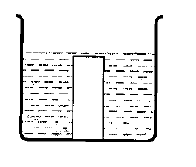A mercury thermometer is to be made with glass tubing of internal bore 0.5 mm diameter and the distance between the fixed point is to be 20 cm. Estimate the volume of the bulb below the lower fixed point, given that the coefficient of cubical expansion of mercury is 0.00018/K. and the coefficient of linear expansion of glass is 0.000009/K.
Let V be the required volume,
Apparent increase in volume =v×γα×100cm3
or V×(0.00018−0.000027)×100
=π×625×10−6×20
or V=π×625×10−6×201.53×10−4=2.57cm3
Topper's Solved these Questions
- CALORIMETRYBOOK - CENGAGE PHYSICSCHAPTER - CALORIMETRYEXERCISE - Exercise 1.3
18 Videos
- CALORIMETRYBOOK - CENGAGE PHYSICSCHAPTER - CALORIMETRYEXERCISE - Subjective
25 Videos
- CALORIMETRYBOOK - CENGAGE PHYSICSCHAPTER - CALORIMETRYEXERCISE - Exercise 1.1
23 Videos
- BASIC MATHEMATICSBOOK - CENGAGE PHYSICSCHAPTER - BASIC MATHEMATICSEXERCISE - Exercise 2.6
20 Videos
- CENTRE OF MASSBOOK - CENGAGE PHYSICSCHAPTER - CENTRE OF MASSEXERCISE - INTEGER_TYPE
1 Video
Similar Questions
A long mercury glass tube with a uniform capillary bore has in it a thread of mercury which is 1m long at 0∘C . What will be its length at 100∘C if the real coefficient of expansion of mercury is 0.000182 and coefficient of cubical expansion of glass equal to 0.000025 ?
View SolutionA Barometer with brass scale, which is correct at 0∘C, reads 75cm on a day when the air temperature is 20∘C. Calculate correct reading at 0∘C. (Coefficient of real expansion of mercury =0.00018/∘C and coefficient of linear expansion of brass =0.000189/∘C.)
View Solution
Knowledge Check
A barometer with a brass scale correct at 0∘C reads 70cm of mercury on a day when the air temperature is 40∘C. The correct reading at 0∘C is (Coefficient of real exapansion of mercury is 0.00018/∘C and coefficient of linear expansion of brass is 0.00018/∘C)
A60.5cmB69.97cmC20.5cmD50.00cmA weight thermometer contains 51g of mercury at 200C and 50g of mercury at 1000C. The coefficient of apparent expansion of mercury in glass vessel is
A25×10−5/0CB2.5×10−3/0CC2×10−5/0CD4×10−4/0C
In a mercury in glass thermometer the cross section of the capillary is A0 and volume of the bulb is V0 at 0∘C. If mercury just fills the bulb at 0∘C, find the that the length of mercury in the capillary at temperature t.∘C. Given that β=coefficient of cubical, expansion on mercury and α= coefficient of linear expansion of glass.
View SolutionA metre scale was calibrated at 0∘C . If at 40∘C is given the distance between two fixed points A and B as 12 mm (see figure ) then what is the actual distance between them , given that coefficient of thermal expansion a=10−5/∘C .

View SolutionA 1-L flask contains some mercury. It is found that at different temperature, the volume of air inside the flask remains the same. What is the volume of mercury in the flask, given that the coefficient of linear expansion of glass=9×10−6/∘C and the coefficient of volume expansion of Hg=1.8×10−4/∘C ?
View SolutionIn a cylidrical glass container a solid silica is placed vertically at its bottom and remaining space is filled with mercury upto the top level of the silica. The volume of silica remains unchanged with variation in temperature. The coefficient of cubical expansion of mercury is γ and coefficient of linear expansion of glass is α. If the top surface of silica and mercury level remain at the same level wiht the variation in temperature then the ratio of volume of silica tothe volume of mercury is equal:

View SolutionA mercury therometer is transferred from melting ice to a hot liquid. The mercury rises 0.95 of the distance between lower and upper fixed points. What is the temperature of the liquied in .∘C and in .∘F ?
View SolutionWhen 50 ml of a liquid is heated through 20∘C, its apparent expansion is 0.5 ml. If the coefficient of linear expansion of the container is 9×10−6K−1, find the coefficient of real expansion of the liquid.
View Solution